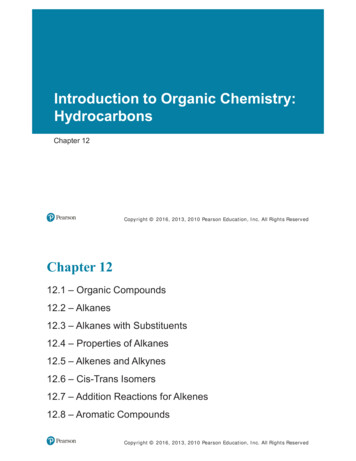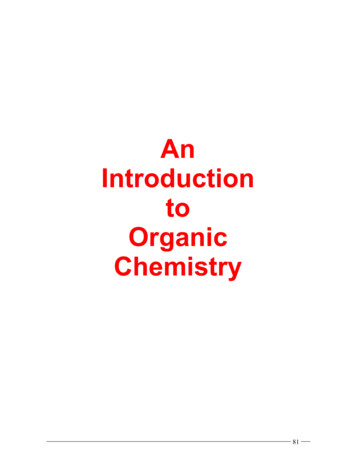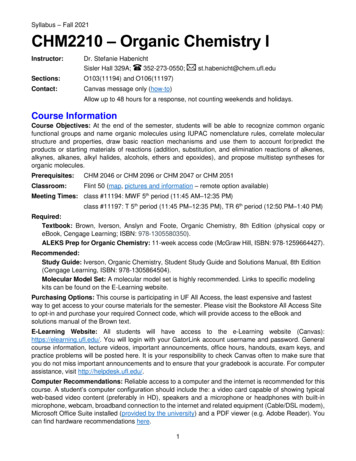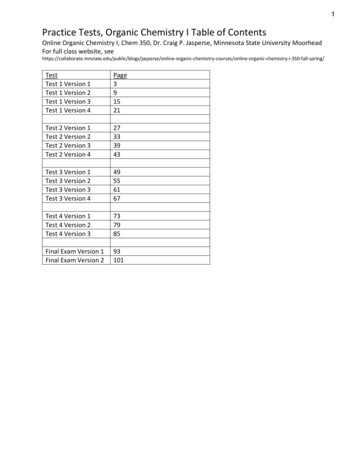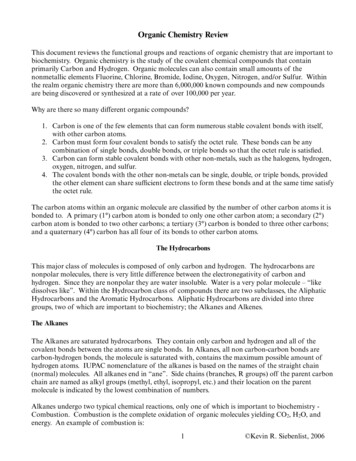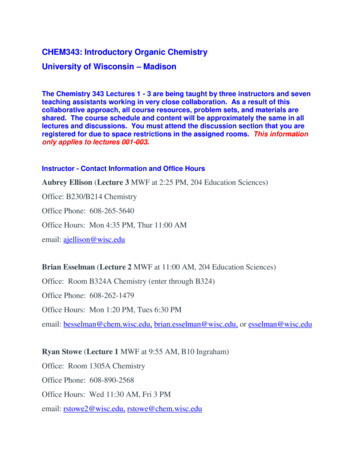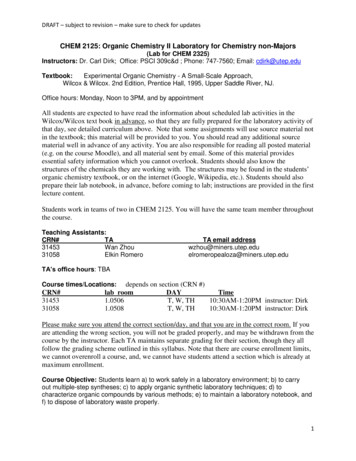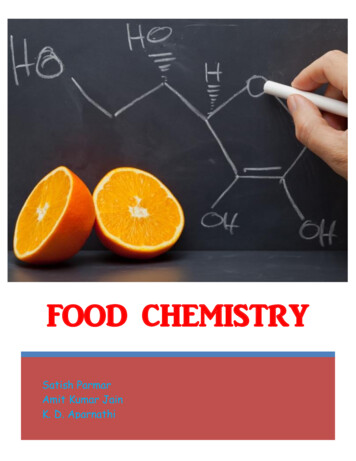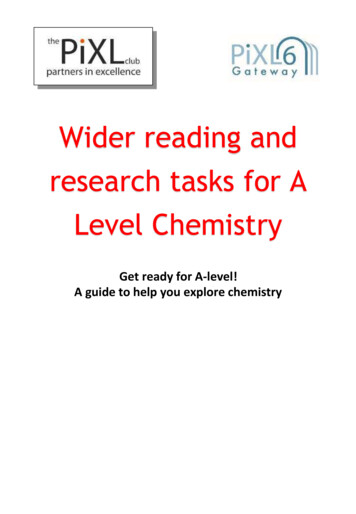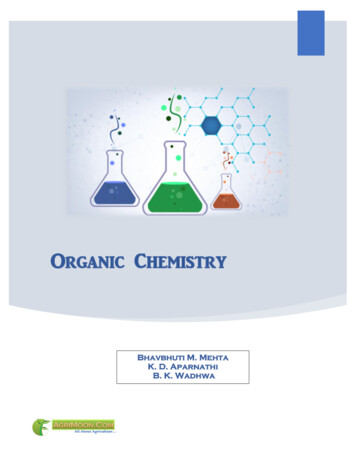
Transcription
Organic ChemistryBhavbhuti M. MehtaK. D. AparnathiB. K. Wadhwa
Organic ChemistryCourse DevelopersBhavbhuti M. Mehta & K. D. AparnathiDeparment of Dairy ChemistryAAU, AnandB. K. WadhwaDairy Chemistry DivisionNDRI, Karnal
LessonModule 1.Lesson 1Lesson 2Lesson 3Name of LessonHydrogen bonding and hydrophobic interactionsConcepts of hydrogen bonding.Inter and intra molecular hydrogen bonding in alcohols,carboxylic acidsand other molecules and theirsignificanceElementary idea of hydrophobicity, hydrophobicinteractions and its importance in the structure of proteinModule 2. Alcohols, Aldehydes and KetonesLesson 4 Important properties of mono, di and trihydric alcohols(Glycol and Glycerol).Lesson 5 Reactions of aldehydes and ketones.Lesson 6 Importance of carbonyl compounds in food flavors.Module 3.Lesson 7Lesson 8Lesson 9Carboxylic acidsIonization constant and strength of carboxylic acids.Important reactions of carboxylic acidDerivatives: esters, amides, lactones and theirpreparation and reactionsLesson 10 Substituted carboxylic acid: halogen, keto and hydroxyacids and theirimportant reactionsModule 4. Amine and phenolsLesson 11 Basic character of amines and their important reactionsLesson 12 Acidic character of phenols and effect of nuclearsubstitution on it. Important reactions of phenolsModule 5.Lesson 13Lesson 14Lesson 15Amino acids and peptidesSynthetic and natural amino acids.General properties of amino acids.Zwitter ion form and its properties viz. melting point andvolatilityLesson 16 Important reactions of amino acids.Module 6. ProteinsLesson 17 Definition and classification of proteins.Lesson 18 A Primary, secondary, tertiary and quaternary structure ofproteinsPage 5-6162-6667-6869-7172-7778-7980-8283-93
Lesson 19 Qualitative test for proteins.Module 7. CarbohydratesLesson 20 Definition, classification and isomerismLesson 21 Structure of glucose - open chain and ring structure andevidences forthe ring structureLesson 22 Stereochemistry and stability of anomersLesson 23 Reactions of monosaccharidesLesson 24 Detection of carbohydratesModule 8. Fatty acids and lipidsLesson 25 Definition and classificationLesson 26 Important reaction of fatty acids (saturated andunsaturated)Lesson 27 Structure and properties of neutral lipids, phospholipidsand 116117-121122-126127-132133-138139
Organic ChemistryModule 1. Hydrogen bonding and hydrophobic interactionsLesson 1CONCEPTS OF HYDROGEN BONDING1.1 Introduction Covalent bond between two atoms - formed by sharing of electrons present in outer most valenceshells of bonding atoms.Covalent bond is formed between two similar or dissimilar atoms. The shared electron pair is attracted equally by both the atomsTherefore, the pair of electrons lies exactly midway between the two bonded atoms.The bond is not polarized – non-polar covalent bond between the identical atoms.Example: molecules are H2, F2, O2, N2, etc.Figure 1.1 Homonuclear diatomic molecules) In case of covalent bond formed between two dissimilar atoms Generally, one of the atoms has a higher affinity for the shared/bonded electrons.Therefore, the shared electron pair is pulled closer to that atom (atom of highelectronegativity elements F, O, N). It is a polarized bond.Examples HF, H2O , NH3(Figure 1.2 Heteronuclear molecules) Such asymmetric distribution of bonded electrons leads development of partial charge on atomsof the molecule called polar covalent bond represented in Fig 1.3.The atoms of electronegative element (F,O, N) acquire partial negative charge.The hydrogen atom acquires partial positive charge denoted as δ .Figure 1.3 Polar covalent bond5
www.AgriMoon.Com The partial positive charge on hydrogen atom in such molecules will be attracted electrostatically by the partial negative charge on atom of the electronegative element in other moleculeof such compound.(Figure 1.4 Intermolecular hydrogen bonding) The electrostatic attraction between hydrogen atom of one molecule and electronegative atom ofanother molecule (generally of the same substance) is known as hydrogen bond/bonding.Hydrogen bond is represented by a dotted line ( .).It is a weak secondary bond with low bond energy and purely electrostatic in nature.It acts as a bridge between two electronegative atoms of the molecules via hydrogen atom.Organic compounds such as given below also form hydrogen bondAlcohols : R-OHPhenols : Ar-OHCarboxylic acids : R-COOHAmines : R-NH2 (Primary) and R2-NH (Secondary)Amides : R-CONH2(Figure 1.5 Hydrogen bonding in organic molecules)6
Organic Chemistry Molecules of water and primary amines- have two hydrogen atoms- therefore involves threehydrogen bonding per molecule.Molecule of other compounds- have only one hydrogen atom- therefore involves two hydrogenbonding per molecule.Amongst the examples given above In carboxylic acids, the hydrogen bonding is limited to the association of two moleculesonly.In other compounds, the hydrogen bonding may extend to several molecules- associationof several molecules.Hydrogen bonding may occur between molecules of different substances also – a commonexample is formation of hydrogen bond between molecule of water and molecule of compoundsreferred above (alcohol, amine, phenol etc.).(Figure 1.6 Solubility on the basis of hydrogen bonding) Even compounds like lower aldehydes and ketones, which do not form hydrogen bond betweentheir own molecules, they do form this bond with molecule of waterTherefore low molecular weight aldehydes (formaldehyde and acetaldehyde) and ketone(acetone) are soluble in water because of hydrogen bonding.Figure 1.7 Solubility of lower aldehydes and ketones on the basis of hydrogen bondingThe extent of hydrogen bonding in alcohols increases as R/OH ratio increases so higher alcohol areinsoluble in water and waxy solids**** ****7
www.AgriMoon.ComLesson 2INTER AND INTRA MOLECULAR HYDROGEN BONDING IN ALCOHOLS, CARBOXYLICACIDS AND OTHER MOLECULES AND THEIR SIGNIFICANCE2.1 Introduction When hydrogen bonding is formed between atoms of different molecules, it is calledintermolecular hydrogen bonding.All the examples given so far in Lesson 1 are of intermolecular hydrogen bonding (HF , H2Oetc).Intermolecular- between different molecules.When hydrogen bonding is formed between atoms of same molecule, it is called intramolecularhydrogen bonding.Intramolecular- within the moleculeExamples are given belowFigure 2.1 Intramolecular hydrogen bonding Intramolecular hydrogen bonding forms when –O-H group and electronegative element atom inthe same molecule are present close together in such a position that a ring can form withoutdisturbing the normal bond angles.The new five- or six- membered rings formed above as a result of intramolecular hydrogenbonding are known as chelate rings and such compounds are often referred to as chelatecompounds (phenomenon as chelation).2.2 Conditions For Hydrogen Bonding An effective hydrogen bond will form only when hydrogen atom is covalently attached to anatom which is Strongly electronegative andSmall in sizeWhen the electronegativity is not high or if that atom has a large atomic radius The electrostatic forces of attraction will be weak andAs a result hydrogen bond will not be very effective8
Organic Chemistry Fluorine, oxygen and nitrogen are the only three elements Which have sufficiently high electronegativity andAre small enough to form effective hydrogen bondsChlorine has electronegativity comparable to that of nitrogen, still it does not form effectivehydrogen bonding due to its relatively larger sizeBromine and iodine are not as highly electronegative as required for hydrogen bonding.2.3 Strength of Hydrogen Bonding Being electrostatic in nature, they are much weaker than the covalent bondsThe strength of a hydrogen bonding is of the order of The strength of a normal covalent bond is of the order of 2 to 10 kcal/mole or10 to 40 kJ/mole (i.e. per 6.022 x 1023 bonds)50-100 kcal/moleGreater the electronegativity and smaller the size of the electronegative atom, stronger is thehydrogen bondTherefore, hydrogen bonding involving F, O or N atoms have strengths of 10, 7 and 2 kcal/molerespectively.2.4 Effects of Hydrogen Bonding on Physical Properties The existence of hydrogen bonding in molecules has a marked effect on their physical propertiessuch as melting and boiling points, solubility, spectral characteristics, density etc.2.4.1 Effect on melting and boiling points Ordinarily, compounds with similar molecular weights have similar melting/boiling points andthere is regular increase in these physical constants with rising molecular weights.Compounds containing intermolecular hydrogen bonding show unusually high melting/boilingpoints.This is evident from boiling points of hydrogen compounds with elements of group V, VI, VIIshown in the Table belowTable 2.1 Boiling point of hydrogen bonded compounds9
www.AgriMoon.Com In the series of hydrogen compounds given below, all the compounds have almost similar mol.wt., but there is a wide difference in their boiling points.Table 2.2 n-Butane contains only hydrogen and carbon lacks protonic hydrogen therefore non-polarcovalent bond- no hydrogen bond formation- no molecular association- lower boiling point.Other compounds contain strongly polar covalent bond (N-H or O-H).Leads formation of intermolecular hydrogen bonding causes large molecular association therefore much more energy would be needed to break them apart - therefore higher boilingpoints.The effect of intramolecular hydrogen bonding on melting/boiling points is opposite to thatobserved in the case of intermolecular hydrogen bondingExample o-Nitrophenol (m.p. 440C) (steam volatile) and p-Nitrophenol (m.p. 1140C) (nonvolatile in steam)10
Organic ChemistryFigure 2.2 Intra- and Inter- molecular hydrogen bonding In ortho derivatives presence of intramolecular hydrogen bonding prevents formation ofintermolecular hydrogen bonding- therefore intermolecular association does not takes placetherefore they have lower melting point and higher volatility.In para derivatives intermolecular hydrogen bonding formation takes places- leads tointermolecular association resulting into an increase in melting point and lower volatility.Another example : cis- and trans isomers of HOOC-CH CH-COOHFigure 2.3 Melting points of Maleic acid and Fumaric acid on the basis of hydrogen bonding2.4.2 Effect on solubility Compounds which can form intermolecular hydrogen bonds with a solvent (water) would begenerally soluble in that solventCompounds in which hydrogen bonding with solvent (water) molecules is restricted (prevented)due to intramolecular hydrogen bonding would be less soluble or insoluble in that solventExamples Hydroxy compounds like methyl alcohol, ethyl alcohol, sugars, etc are highly soluble inwater due to formation of hydrogen bonds between molecules of these compounds andmolecules of waterIn o-nitrophenol, - OH group is not available for hydrogen bonding with water- therefore itis less soluble in water. Whereas, in p-nitrophenol – OH group is available for hydrogenbonding with water - therefore it is more soluble in water2.4.3 Stability of crystal structure Intramolecular hydrogen bonding in maleic acid halves its ability to from intermolecular bondsIn fumaric acid all hydrogen bonds are intermolecular therefore it gives stronger, interlinkedcrystal structure2.4.4 Effect on spectral characteristics Spectral characteristic of compounds are significantly affected if these compounds containhydrogen bonds- examples.11
www.AgriMoon.Com An Infra-red (IR) spectral study of free –OH group at 3500 cm-1 is shifted to lower frequencies ifthe –OH group involves hydrogen bonding -around 3200 cm-1 in alcohol and around 3000 cm1in carboxylic acidsMuch higher shift in the acids compared to alcohols- suggests that H bonds in the acids arestronger than that in alcohols.2.4.5 Unusual behaviors of water Two unusual behaviors of water1. Lower density in solid state (ice) than that in liquid state - therefore ice floats over water –unusual – because density of solid is lower2. Water contract when heated between 00C and 4 0C - volume is minimum at 40C - thereforeits density is maximum at 4 0C - unusual substances expand when heated in alltemperature ranges Both these peculiar features of water are attributed to formation of hydrogen bonding by watermoleculesFigure 2.4 The tetrahedral hydrogen bonded cage-like structure of ice Hydrogen atomsCentral oxygen atomFour oxygen atoms surrounding the central hydrogen atomHydrogen bonding between water molecules is more extensive in ice than in liquid water.Because a substance in solid state has a definite structure and the molecules are more rigidlyfixed relative to one another than in liquid state.In ice, the water molecules are tetrahedrally oriented with respect to one anotherEach oxygen atom is surrounded tetrahedrally by four hydrogen atoms, two of these are bondedcovalently and the other two by hydrogen bondsThe hydrogen bonds are weaker- therefore longer than the covalent bonds- this arrangementgives rise to an open cage-like structure – as indicated in the figure given above.There are number of holes or open spaces – because the hydrogen bonds holding the watermolecules in ice are directed in definite anglesIn liquid water such hydrogen bonds are fewer in numberAs a result, when ice melts a large number of hydrogen bonds are broken and molecules moveinto the ‘holes’ or ‘open space’ - therefore come closer to one another than they were in solidstate.12
Organic Chemistry As liquid water is heated from 0 to 40C, hydrogen bonds continue to be broken and the moleculescome closer and closer togetherThis leads to contraction – decrease in volume- increase in densityOn rise of temperature from 0 to 40C some expansion takes place, but contraction effectpredominates - therefore there is net contraction.Above 40C - expansion effect predominates – rise in volume (d m/v). So water has maximumdensity at 40C since v (volume) is minimum at 40C.2.5 Importance of Hydrogen Bonding Phenomenon of hydrogen bonding formation bears a great significance in various aspects Retention of water on the earth in large amount Without hydrogen bonding, water would have existed as a gas like hydrogensulphideIn that case, no life would have been possible on this globeDetermines and maintains structure of various proteins which are so essential for lifeMakes wood fibers more rigid and thus makes it an article of great utility to meet requirements ofhousing, furniture etcProvides rigidity and tensile strength to cotton and silk fibers which are of vital importance for ourclothingForms linkage with water – cotton cutting takes more time for dryingAffects properties of food constituent – changes viscosity, solubility and stability- desirable orundesirableInvolves in –chemotherapeutic action of drugs, binding of dyes to textiles, adhesive action ofpaints, lacquers etcCollects water in animal and vegetable cells – required for various activities of the cells.Exists a part in biomolecules of living cells – DNA, RNA etcFormation retains moisture in each crust – i.e. with claySurvival of marine life in aquatic regions. Water can form hydrogen bond with very large number of compound – because it can formhydrogen bond by1. Providing protone.g. its hydrogen bond formation with oxygen atom of carbonyl groupFigure 2.5 Hydrogen bonding with carbonyl group2. Accepting protone.g. its hydrogen bond formation with hydrogen atom of amine groups13
www.AgriMoon.ComFigure 2.6 Hydrogen bonding with amino/imino group**** ****14
Organic ChemistryLesson 3ELEMENTARY IDEA OF HYDROPHOBICITY, HYDROPHOBIC INTERACTIONS AND ITSIMPORTANCE IN THE STRUCTURE OF PROTEINS3.1 IntroductionWhen you add some drops of oil to water, the drops combine to form a larger drop. This comes aboutbecause water molecules are attracted to each other and are cohesive because they are polar molecules.Oil molecules are non polar and thus have no charged regions on them. This means that they are neitherrepelled nor attracted to each other. The attractiveness of the water molecules for each other then has theeffect of squeezing the oil drops together to form a larger drop. Since it looks like the oil molecules areavoiding the water, this type of interaction is called a hydrophobic interaction. Hydrophobic interactionis an effective interaction between two nonpolar molecules that tend to avoid water and, as a result,prefer to cluster around each other.Hydrophobic interactions describe the relations between water and hydrophobes (low water-solublemolecules). Hydrophobes are nonpolar molecules and usually have a long chain of carbons that do notinteract with water molecules. The mixing of fat and water is a good example of this particularinteraction. The common misconception is that water and fat doesn’t mix because the Van der Waalsforces that are acting upon both water and fat molecules are too weak. However, this is not the case. Thebehavior of a fat droplet in water has more to do with the enthalpy and entropy of the reaction than itsintermolecular forces.Hydrophobic interactions along with hydrophilic interactions help to determine the three dimensionalshape of biologically important molecules and structures such as proteins and cell membranes.Nonpolar molecules are not good acceptors of the hydrogen bond. When a nonpolar molecule is placedin water, the hydrogen bonding network of water is disrupted. The water molecules therefore reorganizearound the solute and make a sort of cage, similar to the structure of water in ice, in order to gain backthe broken hydrogen bonds. This reorganization results in a considerable loss in the configurationalentropy of water and therefore an increase in the free energy.If there are two or more such nonpolar molecules, the configuration in which they are spatially together(clustered together) is preferred because now the hydrogen bonding network of water is disrupted in one(albeit bigger) pocket, rather than in several small pockets. Therefore, the entropy of water is largerwhen the nonpolar molecules are clustered together, leading to a decrease in the free energy.The hydrophobic interaction is entropy-driven and thus intrinsically temperature sensitive. For instance,the solubility of methane in water decreases with increasing temperature at low temperatures (afterreaching a minimum at about 350 K, the solubility increases with higher temperature). In liquid water, a15
www.AgriMoon.Comsingle water molecule can form four hydrogen bonds with nearby water molecules. However, around anapolar solute, surrounding waters can not form hydrogen bonds with it. Therefore the orientation ofwaters near the hydrophobic solute is more ordered and the entropy of the system is reduced. For thisreason, apolar solutes tend to be lumped together to minimize the number of waters affected by them.3.2 Causes of Hydrophobic InteractionsAmerican chemist Walter Kauzmann discovered that nonpolar substances like fat molecules tend toclump up together rather than distributing itself in a water medium, because this allow the fat moleculesto have minimal contact with water.When a hydrophobe is dropped in an aqueous medium, hydrogen bonds between water molecules willbe broken to make room for the hydrophobe; however, water molecules do not react with hydrophobe.This is considered an endothermic reaction, because when bonds are broken heat is put into the system.Water molecules that are distorted by the presence of the hydrophobe will make new hydrogen bondsand form an ice-like cage structure called a clathrate cage around the hydrophobe. This orientationmakes the system (hydrophobe) more ordered. With a decrease in disorder, the entropy of the systemdecreases.The change in enthalpy of the system can be negative, zero, or positive because the new hydrogen bondscan partially, completely, or over compensate for the hydrogen bonds broken by the entrance of thehydrophobe. The change in enthalpy, however, is insignificant in determining the spontaneity of thereaction (mixing of hydrophobic molecules and water) because the change in entropy is very large.3.3 Strength of Hydrophobic InteractionsHydrophobic interactions are relatively stronger than other weak intermolecular forces (i.e. Van derWaals interactions or Hydrogen bonds). The strength of hydrophobic interactions depends on followingfactors1. TemperatureAs temperature increases, the strength of hydrophobic interactions increases also. However, at anextreme temperature, hydrophobic interactions will denature.2. Number of carbons on the hydrophobesMolecules with the greatest number of carbons will have the strongest hydrophobic interactions.3. The shape of the hydrophobesAliphatic organic molecules have stronger interactions than aromatic compounds. Branches on a carbonchain will reduce the hydrophobic effect of that molecule. This is so because carbon branches producesteric hindrance, so it is harder for two hydrophobes to have very close interactions with each other tominimize their contact to water. The linear carbon chain can produce the largest hydrophobicinteraction.16
Organic Chemistry3.4 Biological Importance of Hydrophobic InteractionsHydrophobic Interactions are important for the folding of proteins. This is important in keeping a proteinalive and biologically active, because it allow to the protein to decrease in surface area and reduce theundesirable interactions with water. Apart from proteins, there are many other biological substances thatrely on hydrophobic interactions for its survival and functions, like the phospholipid bilayer membranesin every cell.**** ****17
www.AgriMoon.ComModule 2. Alcohols, aldehydes and ketonesLesson 4IMPORTANT PROPERTIES OF MONO, DI AND TRIHYDRIC ALCOHOLS (GLYCOL ANDGLYCEROL)4.1 Introduction Organic hydroxyl compounds of the general formula R-OH, where ‘R’ is an alkyl or substitutedalkyl groupFor example(Figure 4.1 Examples of alcohols)Contain hydroxyl (-OH) group as the functional group - determines characteristics and properties of thisfamily.4.2. ClassificationClassified on different basis Based on number of hydroxyl groups1. According to number of hydroxyl groups content2. As mono-, di-, tri- and polyhydroxy(Figure 4.2 Classification on the basis of no. of –OH groups)18
Organic Chemistry Based on kind of carbon atom/ degree of carbon atom to which –OH is attached.1. According to the kind of carbon atom that bears hydroxyl group2. A carbon atom may be classified as primary, secondary and tertiary3. According to number of carbon atoms attached it(Figure 4.3 Classification of alcohols on the basis of nature of carbon atom) Aliphatic alcohols and Aromatic alcohols1. Alcohols of different classes differ in rate and/or mechanism of reaction2. Substitution may also affect the reactivity and physical constants.4.2.1 Physical properties Alcohols are considerably different from hydrocarbons due to presence of polar–OH group – polar compounds Form intermolecular hydrogen bonds – as shown alreadyTherefore;oo Their boiling points are much higherLower members (methanol, ethanol and propanol-1) are miscible with waterEthylene glycol is used as an antifreeze in automobiles.4.2.2 Chemical properties Determined by its functional group- hydroxyl group -OHReactions of an alcohol can involve the breaking of either of two bonds 1. C-OH bond - leads to removal of -OH group or2. O-H bond - leads to removal of -H In either kind substitution or elimination takes place.The substitution replaces –OH or –HThe elimination forms double bond19
www.AgriMoon.Com4.2.3 Industrial sources There are two principal ways to get the simple alcohols by hydration of alkenes and byfermentation of carbohydrates4.2.3.1 Hydration of alkenes Alkene - obtained by cracking of petroleum- converted into alcohol by addition of water(Figure 4.4 Addition of water to alkenes)4.2.3.2 Fermentation of carbohydrates Fermentation of sugars by yeast is used for manufacture of ethyl alcoholFigure 4.5 Fermentation reactions The sugars come from a variety of sources - mostly from molasses from sugar cane or starchfrom grains (maize, peas, potatoes etc).a) Ethyl alcoholWidely used As a solvent for lacquers, varnishes, perfumes and flavoringAs a medium for chemical reactions and in recrystallizationsAs an important raw material for synthesis of aliphatic compounds – alkenes, alkyl halides,ethers, aldehydes, ketones, acids, esters etcIf nothing is mentioned about type of alcohol20
Organic Chemistry To be considered as ethyl alcoholb) 95% ethyl alcohol (an azeotrope constant boiling point mixture) Generally ethyl alcohol used is a mixture of 95% alcohol and 5% waterAfter production alcohol is purified and concentrated by fractional distillationIn distillation first material to distill is the one which has the highest volatility i.e. lowest boilingpointIn a mixture of ethyl alcohol and water the lowest boiling component is not water (boiling point1000C) or ethyl alcohol (boiling point 72.300C) but a mixture of alcohol and water (95:5) sinceits boiling point is 78.150C therefore ethyl alcohol is concentrated upto 95%A liquid mixture that has the peculiar property of giving a vapour of the same composition iscalled azeotrope or constant-boiling mixturec) Absolute alcohol 100% ethyl alcohol is called absolute alcoholObtained by taking advantage of the another azeotropeWhen a mixture containing 150 g of 95% alcohol and 74 g benzene is distilled – a ternaryazeotrope consisting of 7.5% water, 18.5% alcohol and 74% benzene distilled off first due to itslower boiling point (64.900C), leaving pure (anhydrous) alcohol behindTraces of water from the absolute alcohol can be removed by treatment with metallic magnesiumWater is converted into Mg(OH)2 from which alcohol is distilled.**** ****21
www.AgriMoon.ComLesson 5REACTIONS OF ALDEHYDES AND KETONES5.1 Introduction Aldehydes and ketones are compounds of the following general formulaFigure 5.1 Carbonyl compoundsWhere R & R′ are alkyl or aryl groupsIf R& R′ are same: Simple ketonesDifferent: mixed ketones Both aldehydes and ketones contain the carbonyl ( C O) group – therefore collectively termedas carbonyl compounds.This group largely determines the chemistry of aldehydes and ketonesAldehydes and ketones resemble each other closely in most of their propertiesHowever, in aldehydes a hydrogen atom is attached to carbonyl carbon, whereas, in ketones thetwo alkyl groups are attached to the carbonyl carbon.This difference in structure have two effects on their properties1. Aldehydes are more susceptible to oxidation by mild oxidizing agents such as dil. H2SO4/KMnO4 or K2Cr2O7 whereas ketones are oxidized only by drastic oxidizing agents such as conc.HNO3 or H2CrO4.2. Aldehydes are usually more reactive than ketones toward nucleophilic* addition, the characteristicreaction of carbonyl compounds[*Nucleophile/Nucleophilic reagent (Nucleo Nucleus, philes loving/seeking/attaching).An atomic or molecular species which can afford a pair of electrons for covalent-coordinate bondformation is called nucleophile. e.g. OH- , halide ions, NH3 ].22
Organic Chemistry5.2 Structure of Carbonyl Group(Figure 5.2 Structure of carbonyl group) Carbonyl carbon is joined to three other atoms by σ bonds - since formation of these bondsutilizes sp2 orbital, these lie in a plane and 1200apart.The remaining p orbital of the carbon forms π bond with oxygen. Carbon and oxygen are joinedby a double bondThe part of the molecule immediately surrounding carbonyl carbon is flat - i.e. oxygen, carbonylcarbon and other two atoms directly attached to the carbonyl carbon lie in the same plane.The electronegativity of carbonyl carbon and the associated oxygen is quite different - henceelectrons are strongly pulled towards more electronegative oxygen atom - therefore bondbecomes polar.5.2.1 Physical properties1. Formaldehyde is gas at ordinary temperature, however, other aldehyde and ketones up to aboutC11 are colorless mobile liquids and the higher members are solids2. Aldehydes possess an unpleasant pungent odour while ketones have a pleasant smell. However,the higer aldehydes possess fruity odour3. The first few members of both series are fairly soluble in water – because of hydrogen bondingwith water4. Their boiling points are higher than those of alkanes of comparable molecular weight - becauseof polar natureHowever, their boiling points are lower than those of alcohols from which they are made - because lackof hydrogen bond formation between their molecules because they contain hydrogen bonded only tocarbon ( and not with F, O or N).5.2.2 Chemical reactions C O C - O Carbonyl ( C O) group governs the chemistry of aldehydes and ketonesAs discussed earlier carbonyl group is polar and flat23
www.AgriMoon.Com Therefore, it is susceptible to unhindered attack from the above and below in a directionperpendicular to the carbonyl groupIt is highly reactiveThe reactions of carbonyl group generally involve formation of bond with the electron-deficientcarbonyl carbonThe carbonyl group is most susceptible to attack by electron-rich (nucleophilic) reagents e.g. CN, SO3H etc.The reactions are mostly addition reactions - therefore calledNucleophilic addition reactionsCan be represented as shown below (Z nucleophilic reagent or nucleophile)(Figure 5.3 Nucleophilic addition reaction) The nucleophilic reaction of carbonyl group is catalysed by acidsBecause they accentuate the electron-deficiency of the carbonyl carbon by combining with theelectron-rich oxygenThis prior protonation of carbonyl oxygen helps the movement of π electrons towards oxygen andlower the activation energy o
Organic Chemistry 7 Molecules of water and primary amines- have two hydrogen atoms- therefore involves three hydrogen bonding per molecule. Molecule of other compounds- have only one hydrogen atom- therefore involves two hydrogen bonding per molecule. Amongst the examples given above In carboxylic acids, the hydrogen bonding is limited to the association of two molecules

